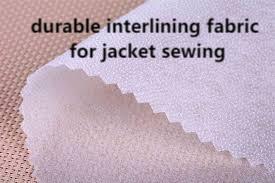In garment design, the unseen layer that gives shape and resilience is often the Interlining positioned between facing and outer fabric, quietly defining fit and finish. Choosing an appropriate mid-layer early in the design process influences how a collar keeps its line, how waistbands support, and how hems drape over time. Thoughtful selection ensures garments perform as intended across wear, laundering, and seasonal changes.
The Hidden Role in Shape and Fit
The mid-layer acts like a small structural team inside a garment: it supports, stabilizes, and shapes without calling attention to itself. For tailored pieces, this support defines silhouettes and provides a crispness that signals quality. In softer styles, a subtler reinforcement preserves drape while preventing early deformation. Designers who respect this hidden element gain more control over final proportions and tactile experience.
Material Choices and Textile Pairing
Not all supportive layers behave the same. Options range from very thin, almost invisible sheets that preserve fluidity, to more robust constructions that add heft and definition. Matching the right material to the outer fabric is critical: a stiff support paired with a lightweight voile will create unwanted bulk, while an ultra-soft layer under a heavy wool may fail to provide adequate structure. Testing combinations in sample runs reduces surprises in final production.
Production Impacts and Quality Assurance
Choosing the proper mid-layer also affects manufacturing workflows. Sewing, pressing, and trimming behave differently depending on the support’s bonding method and thermal tolerance. Good practice includes running pilot batches to identify issues like puckering, adhesive migration, or inconsistent shrinkage. Robust quality control procedures — from incoming material checks to post-laundering assessments — ensure that products shipped to market meet expectations for durability and appearance.
Design Innovation and Brand Applications (Interlining-Factory)
Creative teams are using the mid-layer to push boundaries, blending comfort with architectural form. Recent examples include reinforcing accessory panels, stabilizing applied embroidery, and integrating zones with varying rigidity to achieve dynamic silhouettes. Brands that experiment with graded support or hybrid constructions can introduce fresh aesthetics while maintaining wearer comfort, opening new possibilities for seasonal collections and signature styles.
Lifecycle Thinking and Environmental Considerations
Sustainability has shifted from a buzzword to a design criterion, and the choice of mid-layer material plays a part. Selecting recyclable or responsibly sourced options can reduce environmental impact and extend garment life, lowering the need for frequent replacement. Additionally, considering end-of-life scenarios — such as recyclability or compostability — helps designers make choices that align with circular-economy goals. Care labeling and consumer guidance on maintenance also extend usable life, reducing textile waste.
Practical Tips for Makers and Designers
Start material selection early and treat the hidden support as part of the design language. Prototype multiple options and evaluate how each choice affects drape, hand, and sewing performance. Communicate clearly with suppliers about tolerance ranges and batch consistency. When scaling production, maintain sample references and conduct periodic checks to ensure that incoming material matches the tested standards. Small upfront investments in testing save significant time and cost during mass production.
Final Thoughts
The unseen middle layer is a key contributor to garment success: it balances aesthetic intent with functional performance, and when selected thoughtfully it enhances both longevity and wearability. By treating this element as an integral part of the design and manufacturing process, brands and makers can deliver garments that look better, wear better, and align with evolving sustainability priorities. For further information and technical guidance on supportive layers and their applications, visit https://www.interlining-factory.com/news/what-is-interlining-types-applications-and-more.html

